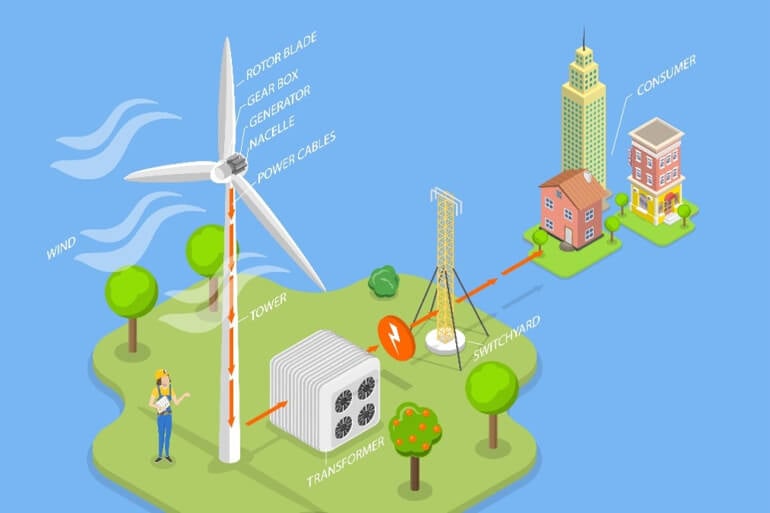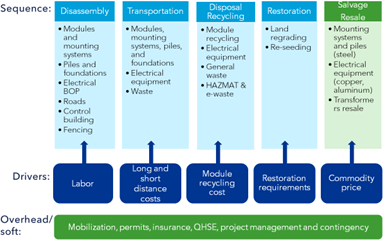Begin at the end: the cost of decommissioning renewable energy projects
Decommissioning cost estimates should account for overhead and soft costs, disassembly of the project components, transportation of the components to their end-of-life destination, restoration of land, and management of components.
When wind and solar projects first entered the generation mix, more attention was paid to questions about reliability and costs than to what to do at the projects’ end of life (EOL). Naturally, looking at energy performance was next—investors wanted to make sure assets were being operated at their maximum safe capacity. As an industry, we’ve learned a lot from our experience with wind projects and applied those lessons to solar. We’re doing the same with the cumulative lessons learned from wind and solar and applying them to battery energy storage (the “new kid in the block”). Each time we try to “get it right from the get-go”, to increase our success rate to the highest point.
Although few wind energy projects in North America have reached the end of their originally expected operational period of 20 years, one of the lessons we’ve learned is that correct planning for EOL considerations has to be part of the development phase of a project. Indeed, the province of Alberta recently instituted a 6-month moratorium on renewable energy projects, in part due to concerns regarding decommissioning and site restoration. Having a plan for the entire lifetime of the project—including EOL—is a best practice recommended by DNV. As such, the full costs of the project, from construction to decommissioning, are accounted for, which can mitigate risks and ensure project success.
Since DNV began preparing decommissioning studies in the early 2010’s, we’ve had one goal: good planning for the responsible decommissioning of renewable energy projects. Decommissioning planning will become more urgent as the amount of renewable generation in the grid increases. DNV’s recent Energy Transition Outlook North America forecasts that wind and solar will begin to dominate the power supply mix in the coming years, growing from 14% of grid-connected electricity generation in the U.S. and Canada in 2022, to more than 81% by 2050—which means there will be many projects to plan for!
Requirements for decommissioning plans vary across jurisdictions, with plan requirements set typically at the county, city, or town level, and sometimes, but much less frequently, at state/province level. These requirements often include a definition of the project’s lifetime, removal depths for underground infrastructure, complete removal of above ground infrastructure, reclamation of land, and a schedule for the project owner to provide updated cost estimates for decommissioning. In certain jurisdictions, notably Quebec, requirements for financial assurances must be provided by the project owner at the permitting phase result in so called decommissioning “bonds.” These financial assurances are there to protect the landowner, as well as the county/city/town from sudden project abandonment by the project owner. That said, after 20+ years working in this industry, I’ve never heard of a wind or solar project abandoned by its owner.
After having witnessed the abandonment of oil and gas wells by some oil industry players, it is not surprising that governments and citizens want to avoid the same thing happening with renewable energy projects—they’re also applying their lessons learned. But there’s a very large difference between those wells when compared with wind or solar projects; their infrastructure components are simply not comparable. Before we dive into how to decommission these projects, to get an idea of the typical components of a renewables project by looking at what comprises a wind farm:

Figure 1 – conceptual wind energy project
A wind energy project is made of wind turbines, an underground collection system, a collector substation, roads, and an operations and maintenance (O&M) building.
Wind turbines transform the kinetic energy from the wind into mechanical energy, which is then transformed into electricity at the turbine generator. The electricity goes through a ~600 kV transformer to be then delivered to the collection system. The largest material types in a wind turbine are ferrous metals used to manufacture the tower, the gearbox, the shaft, the bearings, the nacelle nose, and many other components. The second largest material contributor is fiberglass mixed with epoxy, similar to boat hulls, used in the three blades that capture the wind and sometimes in other turbine components such as the nacelle housing. Each wind turbine is mounted on a concrete foundation that provides stability to the structure. These foundations are made from the same type of concrete used for our homes and other buildings, although with varying shapes and volumes.
The collection system is made of underground cabling that allows for the electricity to flow between each turbine position and the collector substation. Much like the wires in the walls of our homes bring the electricity from a nearby utility transformer to each of the power outlets, this system brings the electricity to the substation, but in the opposite direction and certainly at much higher quantities. These cables are mainly made of aluminum and copper, covered with isolating materials, again much like the wires in our homes. Fiber cable is also buried next to the power cables, carrying telecommunication signals essential to the successful wind farm operation.
The collector substation is where all the underground cables from all the turbines deliver their electricity. It’s made of high-voltage equipment such as air breakers, switches, capacitors, and transformers, to name the most common. Most of this equipment is also made of some type of metal. The main power transformer will sit on top of a concrete foundation that is no bigger than one for a turbine, as the transformer is lighter.
Roads allow the operational crew at the wind farm to reach each wind turbine to perform maintenance activities when necessary. These roads are no different from other secondary dirt roads in the country, typically composed of compacted gravel, geotextile, and sometimes a cement mix.
O&M building is the operational crew center of command, usually equipped with utilities and computers. Some O&M buildings have a warehouse attached to it, where replacement parts for wind turbines are kept and used when needed. The materials of an O&M building will match the local typical construction depending on the weather conditions. The O&M building sits on a concrete foundation as well, just like a house.
A solar energy project is generally made of the same components as a wind project, but the energy transformation is carried out by photovoltaic modules instead of by wind turbines. The PV modules convert the sunlight into electricity, and then deliver the electricity to the collection system. The collection system of a solar project is a little more complicated than that of a wind project, as it uses more power electronic components such as inverters and optimizers as well as other control devices. These power electronic devices are much like what you’d find in the interior of a household electronic appliance, but on a much larger scale.
Inevitably, all projects will reach the end of their lives, and that’s where carefully planned decommissioning comes in. DNV’s recommended approach is simply building in reverse, taking apart the structures the same way they were constructed. Whether the project is wind or solar, the general principles of decommissioning apply. Following these principles DNV has provided the renewable energy industry with decommissioning cost estimates for over a decade, representing more than 16 GW of power. Decommissioning cost estimates should account for overhead and soft costs, disassembly of the project components, transportation of the components to their EOL destination, restoration of land, and EOL management of components. Figure 2 shows these concepts in a sequential manner from left to right for a solar project.

Figure 2 – Decommissioning cost model for a solar project
Here’s a breakdown of what these cost categories include:
- Overhead and soft costs cover the permitting, insurance, preparation, and implementation of QHSE plans, project management and others.
- Disassembly is where the labor and equipment costs are accounted for. This includes the contractors that will be required to dismantle the different project components.
- Transportation includes the hauling costs for moving the dismantled equipment to recycling centers, salvage centers and landfills. Some equipment requires large trucks, some others don’t, some equipment would find their EOL destination in the project vicinity while others will travel larger distances.
- Fees and/or revenue from dismantled equipment when it reaches its EOL destination, like the landfill (fee) or a scrap yard (revenue). Usually, the revenue generated does not cancel out the fees, so the cost may be lowered, but still needs to be factored in.
- Final restoration activities, which typically include backfilling holes, adding back topsoil and reseeding, are carried out while the dismantled equipment is transported to the EOL destination.
The net decommissioning cost estimate is the sum of the values described above.
Everything, even renewables projects, will reach the end of its useful life at some point. The key, especially for these capital- and infrastructure-intensive projects, is to be prepared when that time comes. While there the concern that these projects will be abandoned because the costs to decommission them is unexpectedly high, baking in these costs at the very beginning of the project and following a methodology like DNV’s can ensure that the value they provided during their life is not nullified by what happens when the end comes.
Learn more about how DNV helps project developers and owners plan, operate, and manage their renewables projects from planning all the way through decommissioning.
10/16/2023 3:00:00 PM
